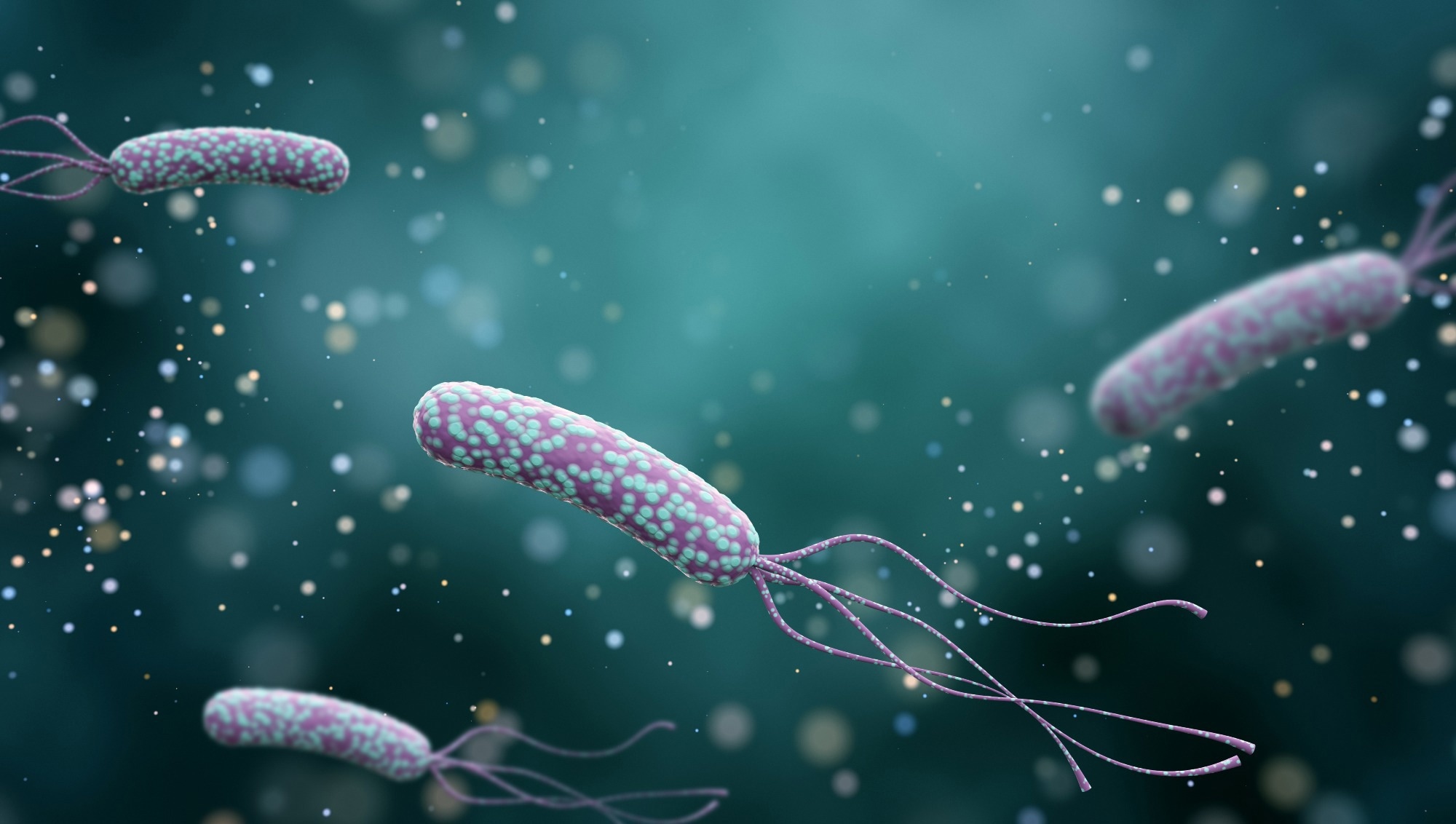How does Helicobacter pylori infection influence rheumatoid arthritis?
A recent Scientific Reports study determined the association between Helicobacter pylori infection and rheumatoid arthritis (RA).
 Study: Influence of Helicobacter pylori infection on risk of rheumatoid arthritis: a nationwide population-based study. Image Credit: K_E_N/Shutterstock.com
Study: Influence of Helicobacter pylori infection on risk of rheumatoid arthritis: a nationwide population-based study. Image Credit: K_E_N/Shutterstock.com
Background
RA is a chronic autoimmune systemic inflammatory disorder that mainly affects the joints. Some common clinical manifestations of RA are pain, swelling, and joint stiffness.
If RA is left untreated, it may lead to joint deformities and disability. To date, the main cause of RA has remained elusive. However, RA has been associated with environmental and genetic factors that trigger autoimmune reactions.
H. pylori is a gram-negative, spiral-shaped, microaerophilic, flagellated bacterium that causes human infection. A persistent H. pylori infection triggers the immune system and causes continuous cytokine signaling from epithelial cells.
This leads to a continual infiltration of gastric mucosa by lymphocytes, neutrophils, and macrophages. Furthermore, continuous generation of antibodies and effector T cells (Th1 and Th2 components) occurs.
Several studies have shown that chronic H. pylori infection is associated with autoimmune diseases. Even though a limited number of studies have established a link between H. pylori infection and RA, these studies have presented contradictory results.
For instance, some of these studies have observed a positive association, while others have noted a negative correlation between H. pylori infection and RA.
About the study
Considering the aforementioned contradictory association between RA and H. pylori, the current study used a nationwide, longitudinal, population-based retrospective cohort to confirm the same.
The current prospective cohort study used relevant data from the Longitudinal Health Insurance Research Database (LHID), which contains around 2,000,000 individuals.
This database is linked with the National Health Insurance Research Database (NHIRD), a population-based insurance system enrolling more than 99% of the Taiwanese population.
Individuals diagnosed with H. pylori infection between 2000 and 2017 were included in this study. Other inclusion criteria besides confirmed H. pylori infection were gastrointestinal tract hemorrhage or peptic ulcer, and H. pylori eradication therapy.
This infection is commonly treated with standard triple therapy and bismuth-containing quadruple therapy. The triple therapy is associated with a combined treatment of proton pump inhibitors, tetracycline/amoxicillin, and clarithromycin/metronidazole.
Patients with a history of RA or cancer were excluded from the cohort. The control cohort comprised individuals who had not undergone anti-H. pylori treatment.
Study findings
In this study, the propensity score was matched for age, sex, index year, urbanization, insurance coverage, and comorbidities, such that two cohorts, i.e., the H. pylori and the control groups, were balanced. The average follow-up duration was around 126 months for the H. pylori group and 122 months for control.
The current study highlighted that the development of RA was significantly associated with H. pylori infection. Compared to the control group, the prevalence of RA was considerably higher in the H. pylori-infected group during the follow-up interval.
Notably, RA incidence was considerably higher in individuals, both male and female, under the age of 30 years being diagnosed with H. pylori infection.
Several virulent factors have been identified, such as vacuolating cytotoxin A (VacA) and cytotoxin-associated gene A (CagA), linked with H. pylori infection.
VacA causes epithelial cell damage, while CagA is translocated to the gastric epithelium and increases the secretion of pro-inflammatory cytokines, causing gastric inflammation.
The relationship between RA and H. pylori depends on the virulence of the infecting strain. For instance, H. pylori CagA-positive strains cause more serious inflammatory reactions and adverse clinical consequences.
Several studies have shown that compared to CagA-negative patients, H. pylori CagA-positive patients develop more severe RA. These findings imply that H. pylori infection could be one of the pathogenesis of RA.
A recent study has indicated that H. pylori interacts with the gastrointestinal microbiome and causes dysbiosis, a contributing factor to autoimmune arthritis. Typically, H. pylori infection causes alteration in large intestinal microbiota via stomach immunopathogenesis.
The current study hypothesized that the increased incidence of RA in H. pylori-infected patients could be due to immune dysregulation, chronic inflammatory response, and autoimmune reaction due to infection.
Conclusions
This study used a nationwide, population-based dataset to reveal a higher risk of RA in individuals with H. pylori infection. This finding will help clinicians remain vigilant about the risk of RA following H. pylori infection.
In the future, more research is required to uncover the underlying mechanism by which H. pylori affects immunological response and gastrointestinal microbiome, which leads to RA.
-
Lee, T. et al. (2023) "Influence of Helicobacter pylori infection on risk of rheumatoid arthritis: a nationwide population-based study", Scientific Reports, 13(1). doi: 10.1038/s41598-023-42207-w. https://www.nature.com/articles/s41598-023-42207-w
Posted in: Medical Science News | Medical Research News | Medical Condition News | Disease/Infection News
Tags: Amoxicillin, Antibodies, Arthritis, Bismuth, Cancer, Cell, Chronic, Cytokine, Cytokines, Disability, Dysbiosis, Gastrointestinal Tract, Gene, Genetic, Health Insurance, Helicobacter pylori, Helicobacter pylori Infection, Immune System, Inflammation, Joint Stiffness, Metronidazole, Microbiome, Neutrophils, Pain, Peptic Ulcer, Research, Rheumatoid Arthritis, Stomach, Tetracycline, Ulcer

Written by
Dr. Priyom Bose
Priyom holds a Ph.D. in Plant Biology and Biotechnology from the University of Madras, India. She is an active researcher and an experienced science writer. Priyom has also co-authored several original research articles that have been published in reputed peer-reviewed journals. She is also an avid reader and an amateur photographer.